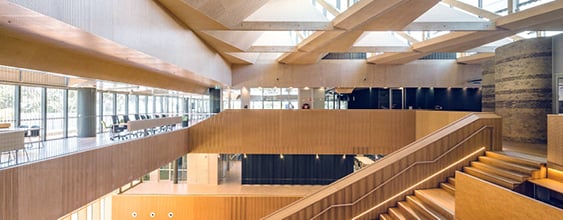Epping to Thornleigh Third Track (ETTT) is a key component of the Northern Sydney Freight Corridor Program, an initiative to improve the capacity and reliability for freight trains on the Main North Line between Sydney and Newcastle. The third track separates northbound freight from all-stops passenger train movements along the steep incline between Epping and Thornleigh, providing additional capacity for northbound (interstate container) freight trains.
It involved the construction of six kilometres of new and upgrades at Cheltenham, Pennant Hills and Beecroft Stations and a new rail bridge across the M2 and Devlins Creek. The project was delivered by an alliance.
On this project we provided:
- Ecological assessment and the ecological impact assessment
- Signalling technical advice
- Detailed design and construction phase services for the 160 m, 11-span prestressed/post-tensioned concrete viaduct
Minimising Ecological Impacts
We were first engaged to undertake ecological assessment. As part of this role we:
- Surveyed and assessed the existing natural environment for terrestrial and aquatic flora and their habitats
- Identified 'biodiversity hotspots' along the proposed rail route and potentially significant biological impacts
- Provided mitigation measures and indicative assessments of significance required under the Environmental Planning and Assessment Act 1979 and the (Commonwealth) Environment Protection and Biodiversity Conservation Act 1999
In consultation with local and state government authorities, we played a key role in identifying biodiversity offsets for the project using the BioBanking Assessment Methodology and in developing an offset strategy.
The environmental assessment included public exhibition, extensive consultation and a comprehensive report that responded to public submissions. In July 2013, planning approval was granted and early construction started the following month.
Improving Rail Safety with Signalling
In our role as signalling technical advisor we:
- Progressed the reference design to detail design for RailCorp approval (blue copies)
- Progressed blue copies to Approved for Construction (AFC) (green copies)
- Progressed AFC (green copies) to testing (pink copies), commissioning (yellow copies) and as-built documentation (white copies)
- Prepared other documentation (including specifications) to the ETTT Alliance to complete the construction works
- Provided construction and commissioning support to the ETTT Alliance
- Provided safety assurance on the signalling design.
To deliver the signalling design, we provided a team of signalling engineers to be based in the client office. The strength of expertise and size of the team allowed us to undertake a wider range of tasks than originally envisioned, using a greater resource level.
Creating Value Through Design Efficiency
The Alliance team approached WSP to re-engineer a major 160 m, 11-span viaduct to improve the construction methodology and create a better value for money design. The detailed design for the viaduct had to be delivered in six months to meet the revised construction program, rather than the typical 9-12 month timeframe. The challenge was to produce an efficient design for the viaduct within the constraints of the other design packages which had already been finalised.
The viaduct design was designed by WSP with construction methodology and value for money in mind. Most of the spans were designed to consist of short span planks that could be lifted quickly during night road closures from a standard length articulated truck. There was also a single span that required a larger opening for maintenance access – this span was designed to be a cast in place post-tensioned through girder that was constructed completely within the site boundary.
By 2016, the project was complete, creating a vital boost to freight capacity and passenger service reliability with minimal impact to the area’s biodiversity.














